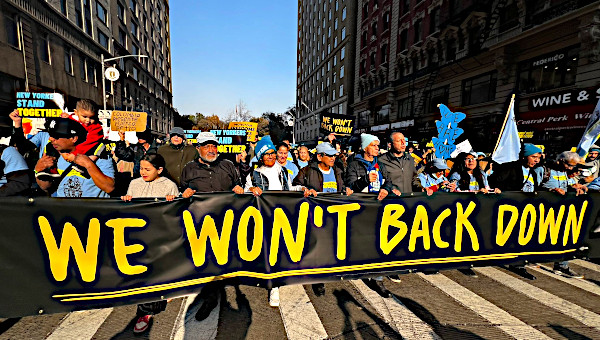The Eighteenth Brumaire of Donald J. Trump: A Response to Bryan Palmer
Bryan Palmer’s recent contribution to The Bullet (September 28, 2020) offers an interpretation of Donald Trump’s class politics, which purports to challenge my comparison of Donald Trump and Louis Napoleon III as Emperors of the Lumpenproletariat (August 30, 2020). Palmer argues that Trump is better understood as the Stalin of Capitalist Counter-Revolution. Despite our different choice of dictators as competing points of comparison, Palmer agrees that “there is much in The Eighteenth Brumaire, as Barrow insists insightfully, that translates easily into an assessment of Donald Trump.” Nevertheless, he is “not convinced that presenting Trump, as Marx does Louis Philippe Bonaparte, as the chief of a déclassé lumpen proletariat, their Emperor brought to power and domination, is useful.”

Palmer’s essay raises three objections to my analysis of Trump as Chief and future Emperor of the Lumpenproletariat. First, he argues that by focusing on Trump and the lumpenproletariat, I fall prey to Trump’s theatrics and deflect attention away from the capitalist class, which is the real class enemy of the working class. Second, Palmer claims that I ignore the role of other classes, particularly the petit bourgeoisie, in explaining Trump’s ascendancy to power. Finally, Palmer argues that the concept of the lumpenproletariat is not a useful tool of analysis, because it is a fluid and heterogeneous social category.
Palmer’s essay neglects many aspects of my analysis and it over-simplifies my position on the role of the lumpenproletariat in contemporary US politics. In doing so, however, Palmer’s essay calls attention to a long-standing unease with the concept of the lumpenproletariat in contemporary Marxist political theory. While Marxists of the 2nd and 3rd International, as well as Marx and Engels before them, grappled hard with the problem of the lumpenproletariat, Marxists began to jettison the concept as an analytic tool in the 1960s, primarily as a reaction to the elevation of the concept by Frantz Fanon and the Black Panther Party, who brought the concept into the heart of New Left political thought and made it the cornerstone of their understanding of the future trajectory of capitalist development in the Global South and the United States, respectively.
What are Trump’s Class Politics?
In contrast to my focus on the lumpenproletariat, Palmer prefers to focus his discussion of Trump’s class politics on Trump’s relationship to the capitalist class. Palmer argues that Trump’s class politics consists mainly of:
“…tax cuts [to corporations and billionaires]; consolidating the hegemony of Wall Street, not only as speculative haven of free-wheeling capital, but as arbiter of the economic well-being of the nation; promoting deregulation so as to liberate commercial power from the constraints of state intervention; securing Supreme Court appointees that will frame law in ways that privilege individual entitlements over collective responsibilities, with the notable exception of a woman’s right to choose; and making America, as a white nation, great again, which centers on symbolism such as Trump’s laughable Wall and trade and tariff policies that will supposedly bring jobs back to the United States industrial heartland.”
Palmer concludes that “the first planks in this agenda have been somewhat successful, winning Trump the support [my italics] of the most belligerent wing of the free-marketeering capital.” In my own analysis, I suggested the same, if only by comparison, with the observation that “Bonaparte’s coup d’état was made possible by the armed support of the lumpenproletariat and it was tolerated by the finance aristocracy [new italics] so long as the latter class was allowed to pillage the state treasury with mounting public debt and corrupt financial schemes – ‘the pettiest knavery’ pursued openly in public view.” In other words, Bonaparte’s policies won him the support of the most speculative free-wheeling capitalists, who were willing to tolerate his buffoonery so long as they could further enrich themselves at the expense of French taxpayers. I believe the comparison is obvious.
At the same time, Palmer argues that “the foundational plank of Trumpism, the attempt to revive the Rust Belt and kick-start an economy collapsing in the throes of deindustrialization, has been a decided bust.” Thus, Palmer chastises me for focusing on a Trump policy failure and for suggesting that “Trump’s 2016 election can be understood as the rise of a Prince and possible future Emperor of the lumpen proletariat.” As an economic policy, there is no question that the border wall and the China tariff war are policy failures – they have not brought jobs back to the industrial heartland – but as political strategies they are a resounding success. I never suggested that Trump has delivered any tangible benefits to the lumpenproletariat, but instead I wrote that “Trump promises to return the United States to its traditional (if mythical) way of life – white men working good jobs in mines and factories, intact nuclear families, Protestant religious values, and manifest destiny.” To Trump’s base, The Wall, USMCA, immigration controls, the China trade war, and Supreme Court appointees appear to be a fulfillment of those promises and Trump can persuasively argue that he needs four more years to realize the full impact of these policies.
Palmer goes on to argue (and I agree) that “Trump’s willingness to openly espouse the racism, national chauvinism, anti-Semitism, and misogyny that runs rampant in ruling class circles is, among those who have attained the presidency, unique in modern times.” Palmer’s statement has two implications for my own analysis. First, racism, national chauvinism, anti-Semitism, and misogyny are not just views held by a dispossessed white lumpenproletariat, but they are also the heart felt values of many in the capitalist class. Thus, Trump speaks on a cultural level for elements of the capitalist class and the lumpenproletariat, who share common cultural values. In fact, in my forthcoming book, The Dangerous Class (due out on October 16, 2020), I analyze how Marx emphasizes the “lumpen” life style of the most parasitic segments of the capitalist class, which makes its living from gambling (financial speculation), murder (COVID-19 investments), violence (Blackwater), chicanery, con artistry, and theft (Trump), and who regularly pursue chemically induced lives of debauchery, crudeness, and criminality outside the boundaries of polite ruling class society. Trump’s lifestyle of documented theft and con artistry, consorting with porn stars, allegations of drug abuse (cocaine and Adderall), multiple children (who he neglects) with multiple partners, rape and sexual molestation (according to an ex-wife and own his public statements), threats of violence, and flagrant unpunished criminality models the lifestyle of a successful lumpenproletarian. The cultural affinity between the most parasitic and disreputable elements of finance capital and the lumpenproletariat make it possible for each of them to see the other as a reflection of themselves. As Marx puts it in The Eighteenth Brumaire: “…this Bonaparte, who constitutes himself chief of the Lumpenproletariat, who here alone rediscovers in mass form the interests which he personally pursues, who recognises in this scum, offal, refuse of all classes the only class upon which he can base himself unconditionally, is the real Bonaparte, the Bonaparte sans phrase.”1 Similarly, in her analysis of the lumpenproletariat, Rosa Luxemburg points out that in the age of finance capitalism “the gradations between commercial profiteering, fictitious deals, adulteration of foodstuffs, cheating, official embezzlement, theft, burglary, and robbery, flow into another in such fashion that the boundary lines between honorable citizenry and the penitentiary has disappeared.”2
However, there is a second implication to Palmer’s analysis, which is that Trump’s “conscious use of this arsenal in appeals to a mobilized mass base of marginalized and often downwardly mobile people may well deflect attention away from those whose interests he routinely serves.” It is implied thereby that talking about the lumpenproletariat deflects attention away from those whose interests are served by Trump. In contrast, I suggest that we can suspend these two ideas in one thought simultaneously as Trump most assuredly pursues both strategies simultaneously. To serve the interests of the most parasitic and corrupt segments of finance capital, Trump must constitute himself Chief of the Lumpenproletariat. As former US President Lyndon B. Johnson once observed: “If you can convince the lowest white man that he’s better than the best colored man, he won’t notice you’re picking his pocket. Hell, give him somebody to look down on, and he’ll empty his pockets for you.”
What about the Petit Bourgeoisie?
Palmer also claims that I ignore the role of other classes, particularly the petit-bourgeoisie, in explaining Trump’s ascendancy to power, but my contribution to The Bullet contains an entire section called “Longing for Greatness, Again,” where I discuss the various roles of finance capital, the petit bourgeoisie, and the lumpenproletariat in Louis Bonaparte III’s rise to state power. In this section, I was making an argument about Trump, admittedly by analogy, but I thought the analogy was obvious.
In “Longing for Greatness, Again,” I argue that The Eighteenth Brumaire chronicles the defection of the peasantry (read: rural and small town America) and the urban petite bourgeoisie from the February Revolution of 1848, because even though they were “working classes,” they were also small proprietors, whose commitment to private property made them leery of the more radical demands for a social republic put forward by the industrial proletariat in the ensuing June Days. These classes were not only threatened by the socialistic demands of the proletariat; they were also nostalgic for an older capitalism based on local small producers and small farmers (peasants) and these were the classes who had flocked to the armies of Emperor Napoleon I – a dictator who had once made France great for them.
However, in The Eighteenth Brumaire, Marx also identifies numerous fractions of the bourgeoisie, which was far from unified in its preferred response to the revolutionary proletariat and even in its commitment to a republic in any form. The bourgeoisie, as Marx defined it, included large landowners (real estate), the finance aristocracy (bankers), large industrialists, and the professions – senior officers of the army, university intellectuals, priests, lawyers, and the press. The division of interest within the bourgeoisie, and the nostalgic longings of the peasants and the petite bourgeoisie, set the stage for Louis Bonaparte’s election as president of the Second Republic in December 1848. However, with waning support in the French National Assembly, and facing the prospect that he would have to leave office due to a likely electoral defeat in 1854, Louis Bonaparte staged a coup d’état on December 2, 1851, with the support of army officers, who led the Mobile Guard and then the Society of 10 December, with the approving acquiescence of the finance aristocracy. Bonaparte had initially won an election with support from the finance aristocracy and the votes of the rural and urban petit bourgeoisie, with the latter swayed by his promise to reduce their taxes and make France great again. However, Bonaparte’s subsequent coup d’état ultimately relied on the mass support and violence of the lumpenproletariat organized and led by his most ardent supporters. In a nutshell, that is my class analysis of Trump’s rise to political power and I consider it a very realistic script for him remaining in power as the lumpenproletariat continues to emerge as an ever more dangerous class in US politics.3
The Concept of the Lumpenproletariat
Finally, Palmer makes a claim about the concept of the lumpenproletariat that has been the prevailing view among Marxists since the early 1960s. He correctly observes that “the entire question of the lumpen proletariat is much debated among Marxists,” because “the lumpen proletariat constitutes a highly volatile, differentiated, and politically unstable social stratum.” In contrast, I am charged with deploying an “undifferentiated” concept of the lumpenproletariat that “is unlikely to explain much about who will rally to Trump.”
A major purpose of my book on The Dangerous Class is to challenge Marxist political theorists who dismiss the concept. I argue that Marx and Engels articulate a complex, but coherent concept of the lumpenproletariat, which they deploy as an economic, cultural, and political category of analysis. More to the point, the lumpenproletariat regularly enters the political stage as a decisive political actor at critical conjunctures of class conflict in many of their historical political writings. The Class Struggles in France and The Eighteenth Brumaire are the most widely read of these writings, but as my book documents, Marx and Engels offer similar analyses in lesser known writings of political events in Germany, Austria, Switzerland, Naples, and Spain. In every single case, revolutionary events follow a similar script, where the lumpenproletariat makes a decisive appearance as the bribed tool of reactionary intrigue – sometimes in the service of monarchs and sometimes in the service of the capitalist class. I contend that Marx and Engels were not deploying the concept of the lumpenproletariat as a mere epithet but were grappling with a real historical problem that regularly confronts the working class when it challenges the existing order. These class struggles have never been decided at the ballot box so electoral statistics count for little in these confrontations.
 At an analytic level, it is not accurate to claim that I deploy an “undifferentiated” concept of the lumpenproletariat.4 My reference to a white lumpenproletariat prima facie implies a certain degree of internal racial differentiation, but in the book I offer a more extensive analysis. I excavate the writings of Marx and Engels to develop the concept of the lumpenproletariat as a social category. The lumpenproletariat – as a pure analytic category – is defined by its non-relation to production and, therefore, it is not a class, but a non-class that is best understood as a social category in the way that Nicos Poulantzas and Robert K. Merton use that term. Its members originate from many different places as there are many paths to becoming a lumpenproletarian: (1) what Marx called the “ruined proletariat”5 (2) the declassed and disintegrating petit bourgeoisie (3) evicted or bankrupted peasants (farmers), (4) landless agricultural laborers who leave the countryside and migrate into cities in search of work, (5) discharged veterans unable to find stable employment, and (6) foreign immigrants who immediately fall to the bottom of the economic hierarchy. This is why Marx and Engels identify the lumpenproletariat as a “passively rotting mass thrown off by the lowest layers of old society.”6 While the old society in 1848 was a decaying feudalism and mercantile economy, the old society of 2020 is a decaying industrial capitalism. A major conclusion of this analysis is that the lumpenproletariat is always a fluid social category that is constantly undergoing a process of composition and re-composition. Moreover, like all social or class formations, the lumpenproletariat is structured as a complex hierarchy of social positions that intersect with race, ethnicity, sex, age, and citizenship status. The lumpenproletariat is not a fixed or static category or group of people. So yes it can get a bit fuzzy and fluid, but I would argue that class boundaries are always fuzzy at the edges, and that all classes are constantly in the process of composition, de-composition, and re-composition, as we learned during the class boundaries debate of the 1970s.7
At an analytic level, it is not accurate to claim that I deploy an “undifferentiated” concept of the lumpenproletariat.4 My reference to a white lumpenproletariat prima facie implies a certain degree of internal racial differentiation, but in the book I offer a more extensive analysis. I excavate the writings of Marx and Engels to develop the concept of the lumpenproletariat as a social category. The lumpenproletariat – as a pure analytic category – is defined by its non-relation to production and, therefore, it is not a class, but a non-class that is best understood as a social category in the way that Nicos Poulantzas and Robert K. Merton use that term. Its members originate from many different places as there are many paths to becoming a lumpenproletarian: (1) what Marx called the “ruined proletariat”5 (2) the declassed and disintegrating petit bourgeoisie (3) evicted or bankrupted peasants (farmers), (4) landless agricultural laborers who leave the countryside and migrate into cities in search of work, (5) discharged veterans unable to find stable employment, and (6) foreign immigrants who immediately fall to the bottom of the economic hierarchy. This is why Marx and Engels identify the lumpenproletariat as a “passively rotting mass thrown off by the lowest layers of old society.”6 While the old society in 1848 was a decaying feudalism and mercantile economy, the old society of 2020 is a decaying industrial capitalism. A major conclusion of this analysis is that the lumpenproletariat is always a fluid social category that is constantly undergoing a process of composition and re-composition. Moreover, like all social or class formations, the lumpenproletariat is structured as a complex hierarchy of social positions that intersect with race, ethnicity, sex, age, and citizenship status. The lumpenproletariat is not a fixed or static category or group of people. So yes it can get a bit fuzzy and fluid, but I would argue that class boundaries are always fuzzy at the edges, and that all classes are constantly in the process of composition, de-composition, and re-composition, as we learned during the class boundaries debate of the 1970s.7
However, as the lumpenproletariat is a non-class, it is not structurally organized by its location in the capitalist mode of production but exists on the outside margins of the capitalist mode of production. It is a by-product – the offal and waste – left behind by capitalist development. The lumpenproletariat’s natural state is to exist as a “passively rotting mass” that constitutes what Marx calls “the lowest sediment of society.”8 As a passively rotting mass, the lumpenproletariat does not have any structurally assigned “historical mission” within capitalism. It must always be organized from the outside by some other class that recruits its members into their service as allies – most frequently as a bribed tool of reactionary intrigue. Without outside direction and leadership, the lumpenproletariat’s natural inclinations when riled by discontent are spontaneous street violence, riots, and vandalism – anarchy (not anarchism). Consequently, to enter the historical stage as anything other than a “mob,” the lumpenproletariat must be organized and activated from the outside, given an identity, and imbued with a political purpose. For Marx, the lumpenproletariat is nearly always enlisted in the service of a counter-revolutionary bourgeoisie; for Fanon, it could be enlisted in the service of an anti-colonial revolutionary peasantry.9
However, once this pure analytic category is delineated, it important to identify who is not a member of the lumpenproletariat. The proletariat is normally identified with full-time workers regardless of whether the working week is 84 hours or 40 hours. It receives a wage sufficient to socially reproduce the class of workers and, in the best of circumstances (1945 to 1975), it may receive health care and an old-age pension. Furthermore, based on Volume 1 of Capital, I argue that the industrial reserve army is not part of the lumpenproletariat, because its members are still attached to the labor market, but temporarily unemployed due to fluctuations in the business cycle. This leaves a wide swath of people between the proletariat and the lumpenproletariat, properly speaking, that Marx calls the relative surplus population, but that some Marxists (e.g., Lenin) have described as semi-proletarians. In one of the last chapters of The Dangerous Class, I argue that this is now the fastest growing sector of post-industrial capitalism and it was this development that Eldridge Cleaver called “the lumpenization of humanity.”10
In fact, Marx refers to service sector workers (a small group in his time) as “the honest lumpenproletariat” – people who worked part-time, seasonally, casually, and often at below subsistence wages and, therefore, relied on tips to survive. On other occasions, Marx and Engels referred to “the working lumpenproletariat” and they mostly used this term when talking about the East End Dock workers in London, who were essentially precarious day laborers. Similarly, Marx puts many other workers into this category: elderly workers who could no longer perform hard labor, former workers disabled by industrial accidents, poor pensioners, de-skilled and de-industrialized workers left behind by new technology, impoverished street vendors, and, of course, widows and orphans, who often worked as domestic servants if they were not reduced to begging or public charity. These groups have some relation to production, but it is tenuous and fragile. Thus, there is an economic spectrum that stretches from the lowest (and most precarious) ranks of the proletariat to the semi-proletariat (irregular employment) to the lumpenproletariat, properly speaking. It is this intermediate segment that poses the contemporary problem of class boundaries.
In their letters, Marx and Engels sometimes share their concern that the honest and working lumpenproletariat is constantly subject to the debasing cultural and political influence of “the lowest sediment of society,” because their poverty and irregular employment force them to live in the lumpenproletarian neighborhoods. At various times, Marx and Engels (and Karl Kautsky) observe a continuous tug of war between the proletariat and the lumpenproletariat (properly speaking) for the hearts and souls of the honest and working lumpenproletariat. The honest and working lumpenproletarians (and their children) are subject to the constant downward pull of lumpenproletarian norms and culture – violence, crime, drugs, unstable and unofficial male-female partnerships, and lack of education and skills, which steadily reproduces the lumpenproletariat on an extended scale (or quite often their children join the military to escape these conditions). This cultural category greatly extends the concept of the lumpenproletariat and it starts to incorporate Bikers for Trump and potentially intersects with, or least runs up against, the boundaries of disaffected, disillusioned, and downwardly mobile sections of the proletariat who also lead an increasingly precarious existence.
This finally leads me to an analysis of the lumpenproletariat as a political category. While I am extending beyond what is in the book, I would now argue that most political movements are coalitions and, therefore, not all of a movement’s members need to be lumpenproletarians (properly speaking) to describe it as lumpenproletarian movement. What is critical in my view is (1) the proportion of the movement that consists of lumpenproletarians (2) whether the leading and active elements of the movement are lumpenproletarian, (3) whether the cultural norms and political goals that define it are lumpenproletarian. Consequently, it is possible that a disaffected proletarian biker could join a lumpen political movement even though he is a dues-paying union member in the same way that an intellectual or lawyer can join a workers’ movement. A biker gang auto worker might fall into a category that is still nominally proletarian at an economic level, but culturally and politically he has become lumpenproletarian.11
Toward an Empire of the Lumpenproletariat
So how does this analysis of the concept of the lumpenproletariat apply to Trump and the 18th Brumaire? I do not think there is any doubt that finance capital is the main economic beneficiary of the Trump regime. They looted the US Treasury for $1.5-trillion in tax reductions and grabbed $1-trillion more in the CARES Act, while the “petty knavery” of Trump’s appointees is probably unprecedented in US political history. However, I do not think most of the billionaire class are fascists, but I do think they are amoral Ayn Rand libertarians, who think correctly that the US government is a clown show and they will laugh their way to the bank so long as Trump continues to deliver for them; and this was the same relation that existed between Louis Bonaparte and the French financiers.
“Barely more than half of US citizens vote in US Presidential elections, which means that a great deal of class struggle takes place outside the electoral system.”
This is where the lumpenproletariat is decisive. Finance capital cannot deliver for itself and Trump cannot deliver for them without a traveling clown show of buffoonery and escalating violence. I wholly agree with Palmer that the petit bourgeoisie is the primary electoral base for Donald Trump, but I would argue that it is the newly minted white lumpenproletariat that provides the margin of victory in places like Minnesota, Wisconsin, Michigan, Pennsylvania, and West Virginia and Trump cannot win without their support – the unemployed iron ore miners in Minnesota, the unemployed auto workers in Wisconsin and Michigan, the unemployed steel workers in Pennsylvania, and the unemployed coal miners in West Virginia, etc. I use the term “unemployed,” but I suggest that we all need to be more circumspect in using this term, because more and more of these jobless former workers are no longer part of the labor force based on US Bureau of Labor Statistics definitions. At what point do we stop referring to former workers as unemployed workers and recognize that they have become lumpenproletarians?
There is one last distinction that I admittedly fail to make clear in my Bullet blog, and in the book, and it is the distinction between Trump’s electoral base and his mass base. This is an important distinction because barely more than half of US citizens vote in US Presidential elections, which means that a great deal of class struggle takes place outside the electoral system. Just as with Louis Bonaparte, the initial electoral victory was based on nostalgic appeals to the petit bourgeoisie, although as I point out the newly minted white lumpenproletariat is also easily hypnotized by nostalgic appeals to America’s industrial past. Trump used his electoral campaign, and his time in office, to mobilize an ever-burgeoning lumpenproletarian mass base – the dangerous class. These are the Decembrists of 2020. These are the people who intimidate peaceful protestors, initiate violence at protests, set fires, storm State Capitols with military weaponry, plot to kidnap governors, and even murder protestors as the police stand by and do nothing. We are seeing these groups escalate their violence as the November 2020 election gets closer and it is the lumpenproletarian shock troops – state-sanctioned paramilitary organizations and civilian militias alike who carry the weapons. The parallels to the Eighteenth Brumaire strike me as so obvious that you could change the names, change the dates, and change the country and it plays out like a Hollywood script written for Trump. I just hope someone turns off the projector before this movie reaches its final scene. •
Endnotes
- Karl Marx, “The Eighteenth Brumaire of Louis Bonaparte,” Marx-Engels Collected Works, Vol. 11 (August 1851-March 1853), pp. 149-50.
- Rosa Luxemburg, The Russian Revolution and Leninism or Marxism? (Ann Arbor: University of Michigan Press, 1961), pp. 73-74.
- For an ominous parallel, see, Mike Giglio, “A Pro-Trump Militant Group Has Recruited Thousands of Police, Soldiers, and Veterans,” The Atlantic (November 2020).
- In the United States, the internal heterogeneity of the lumpenproletariat is magnified by differences of race (black and white), sex (male and female), citizen and non-citizen (immigration status) and each of these structural segmentations is a salient point for organizing and demobilizing the lumpenproletariat.
- The “ruined proletariat” includes workers who have been injured or disabled, mentally disabled workers, the chronically ill, workers who are permanently displaced by new technology, elderly workers who are shunted into lower paying occupations or part-time work, and retirees with meager pensions, among others.
- Karl Marx and Frederick Engels, “The Communist Manifesto,” in Marx-Engels Collected Works (London: Lawrence and Wishart), Vol. 6 (Autumn 1845- March 1848), p. 494.
- Erik Olin Wright, “Class Boundaries in Advanced Capitalist Societies,” New Left Review (July August 1976); Erik Olin Wright, Class, Crisis, and the State (London: New Left Books, 1978).
- Karl Marx, Capital: A Critique of Political Economy, Vol. 1 (Chicago: Charles H. Kerr & Co., 1906), p. 706.
- Frantz Fanon, The Wretched of the Earth, translated by Constance Farrington (New York: Grove Press, 1963), pp. 126-31 assigned this leadership and organizing role to the intellectuals.
- Eldridge Cleaver, “On Lumpen Ideology,” The Black Scholar, Vol. 4, No. 3 (November-December 1972), p. 5.
- I contend that a 30-year old high school dropout, who is unemployed and lives with his upper-middle class parents is a lumpenproletarian by class position regardless of his parents’ class position. I say this only to counter arguments that groups such as the Proud Boys are middle class, and not lumpenproletarian, merely because they wear a Polo shirt their mother bought for them.





